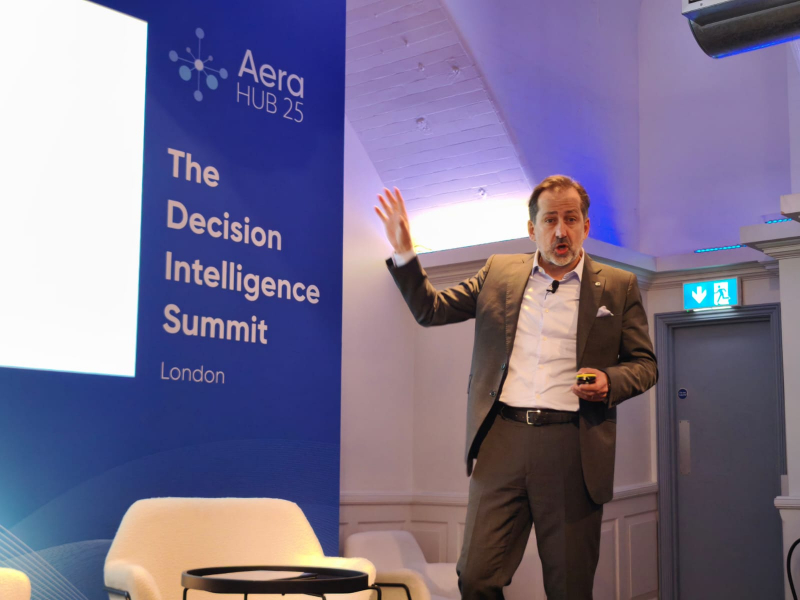Aera Technology used its AeraHUB 25 London event this June to explain when, where and how its Aera Decision Cloud service and its composable Aera Skills technology enables users to grasp what it calls ‘people-centric’ decision digitisation. With natural language query functionalities and a technology base that spans everything from intelligent inventory management to pre-emptive (and fully automated) business decision making, the company insists it has a progressive approach to business intelligence that is far more than just another agentic AI service.
While a formalised notion of the “intelligence industry” is hard to pin down – after all, intelligence could be argued to span education & learning, military and national defence, the study of cognitive thought and of course AI – the technology industry now appears to be moving to formalise and productise decision intelligence in ways that can be embedded into workflows across all industry sectors.
This is by no means the mission statement offered by decision intelligence platform company Aera Technology, but it does go some way to explaining how the organisation now comes to market with its decision intelligence agent service that offers real-time always-on recommendations to direct business outcomes. The company used its UK technology practitioner summit this month to explain where its platform and roadmap goes next in a market where agentic intelligence itself appears to be proliferating and mushrooming at every level.
AeraHUB 25 London
Described as a decision intelligence summit, AeraHUB 25 London was staged this week to explain how the company is introducing a new wave of agentic AI capabilities designed for users “across roles and experience levels” to harness AI for decision making.
Aera talks about what it calls “people-centric decision intelligence” that spans an execution zone from the frontlines (i.e. sales and go-to-market employees) to the back office. This breadth, says the company, enables any user to build Aera Skills decision logic with natural language prompting.
Data Wizard, works like magic
A new AI-powered Data Wizard allows data to be uploaded and categorised, while an enhanced Aera Chat interface delivers real-time insights. The smart Data Wizard technology allows users to upload data as it then automatically classifies and prepares it for use; no technical training is required.
#“Aera Decision Cloud is the only platform that unifies the full decision-making context, [it does this by] blending structured and unstructured enterprise data, human expertise and the reasoning capabilities of large language models,” said Fred Laluyaux, co-founder, president and CEO of Aera Technology. “By putting these advanced capabilities directly in the hands of users, we’re helping organisations achieve new levels of speed and agility in an increasingly complex world.”
Laluyaux suggests that his firm’s technology progression comes at a pivotal time, when the speed and precision of decision execution can determine business success and when organisations face ongoing talent shortages, reskilling needs and increasing pressure to achieve tangible outcomes using AI technologies.
“Aera Technology’s latest release redefines how decisions are made. By placing humans (regardless of technical expertise) at the centre of creating AI-powered decision flows, Aera enables a shift from people doing data analysis to people architecting decision automation and overseeing action. This shift empowers business experts to increase their productivity and strategic impact,” said Laluyaux and team.
Key platform functions
Aera used its AeraHUB 25 London event to explain how Aera Skills works with embedded AI agents that reason and act based on natural language instructions with built-in guardrails that ensure transparency, accountability and governance.
Graham Sommer, executive VP and head of customer operations at Unilever, joined CEO Laluyaux on stage this week to explain how his planing role covers forecasting, order-to-cash cycle and all the way through to warehousing and logistics. With over 400 brands to manage across the entire Unilever, Sommer says the company is now starting to introduce agentic services into the company’s teams.
“In demand creation, we started with a pilot in Mexico and we wanted to understand how to work with sales data in the store, at the source. If a company sells 100 products, it needs a replenishment function to make 100,” said Sommer.
Talking about his firm’s use of forecasting models, his teams work to create sales data that is closely attuned to the way products actually go off the shelves in the stores. This helps create an end-to-end inventory chain that helps reduce a business’s costs, reduce the total capacity needed for inventory and be able to focus on higher revenue actions.
Python, even without the bite
“In terms of people, we looked at the traditional training programmes rolling out across our teams and we realised that for the roles of the future, we needed to focus on digital skillsets. We even teach people – who may never actually end up physically coding – the basics of how to code in Python… and even if they never code themselves, it’s so important for them to know how this process works, all of which ultimately helps employees have the trust needed to use tools built on these technologies.
Aera’s technology is able to work with any data in any format, so that means users are able to tap into both structured and unstructured data sources from transactional systems to PDFs and emails to inform context-rich decisions. Users can ask complex data-driven questions in natural language and receive precise answers with execution capabilities built directly into the chat. Capable of integrating structured and unstructured data from systems, documents and emails to automate complex processes such as claims management, procurement negotiations and contract compliance, Aera says that its platform is capable of defining “decision intent” in natural language.
The company’s agentic AI handles the reasoning part of the equation and generates the “decision logic” needed to help human employees as it also communicates and coordinates across people, systems and vendors, automating decision processes, such as negotiating order modifications.
An extended technical session at AeraHUB 25 London dove into how the Aera Chat technology service works. With a specific ability to configure the analytics tool’s action and ingest live data, Aera executives explained how visualisations are built to explain what enterprise data signals users need to look at. Further, the technology also offers “explainability” so that users can see how data is being treated and processed to form the agentic decisions being offered.
Looking at the Aera Workspaces offering, presenters demonstrated how data, tools, analytics and automation are being used to provide more power forward to end users i.e. by showcasing all the working elements of data science being used (from modeling to calculations to agents and so on), users can get more direct influence over how analytics are being carried out. This particular feature was previously only seen by Aera software application development professionals, but the company has decided to democratise this option for all users. Aera Workspaces is said to offer a “single unified experience” for decision intelligence work.
An industrial AI revolution
As the development zone for agent-driven reasoning to drive business intelligence continues to expand, we are (arguably) some way onward from the standardised “systems of record & systems of transaction” extensions to the ERP systems of yesteryear. Even as those ERP suites were augmented with two decades’ worth of dedicated Business Intelligence (BI) functions, we were still some way off the AI-fuelled automations of today. If that helps us to now codify and establish a more formally defined intelligence industry or age of intelligence, then that may serve as a good marker so that we can look at how and where AI (from Aera Technology and others) continues to develop next.

Fred Laluyaux, co-founder, president and CEO of Aera Technology.
